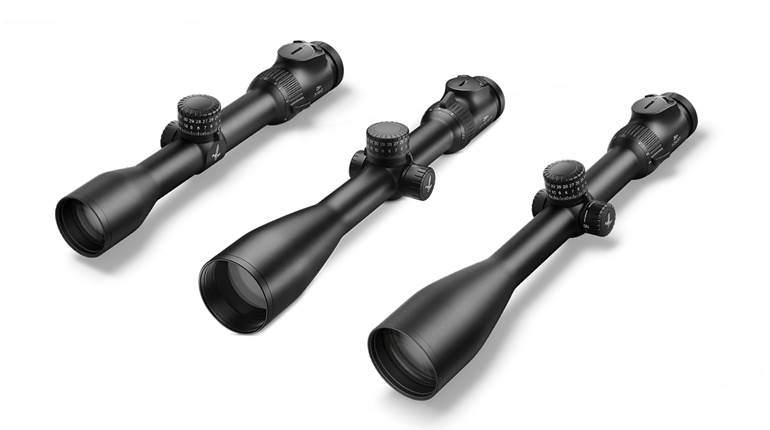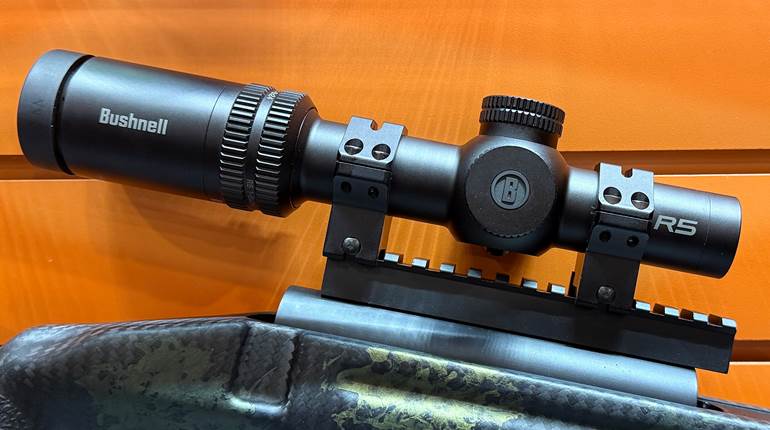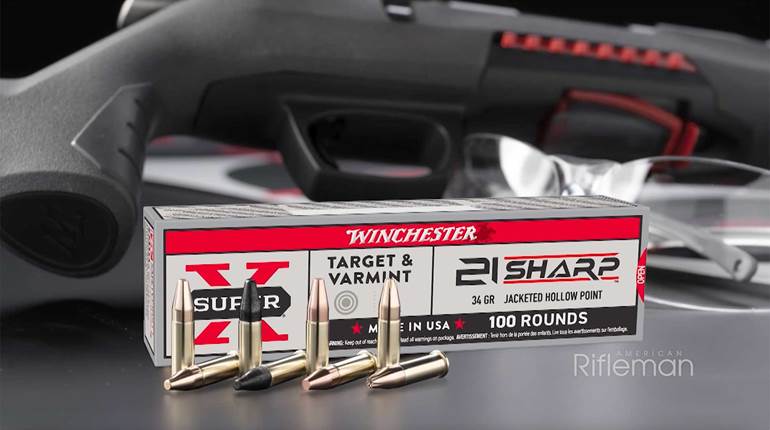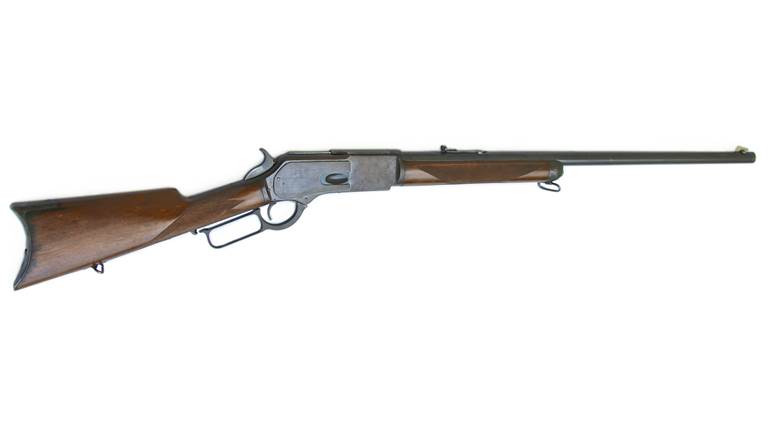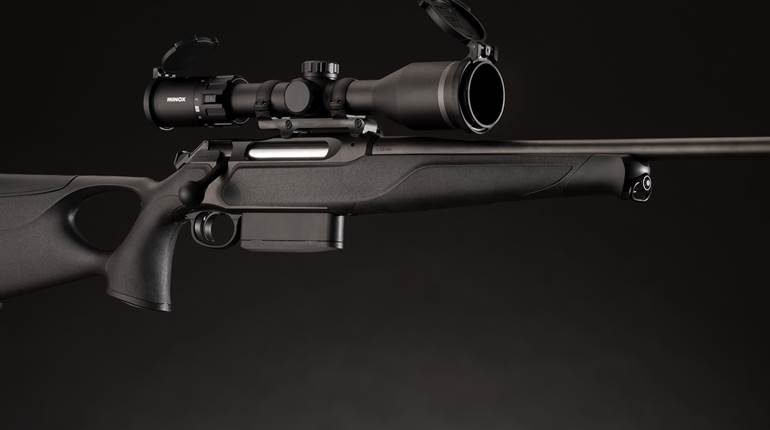
Timing, as they say, is everything. John Hill Redfield, born in Oregon in 1859, was an expert marksman, a tinkerer, an innovator and a perfectionist, and he hung out his shingle as a gunsmith in Oregon in the 1890s. He moved to Colorado in 1906 to peddle his Redfield rock drill to the burgeoning mining industry in the Rockies. But, as the mining boom was headed toward a bust, Redfield believed the gun sight business might be a more promising direction. John knew guns, and he knew shooters needed better sights as they entered a new century of incredible firearm and ballistic innovation. He designed sights, as well as mounts, for hunting and competition shooting. His sight business, started in his Denver garage in 1909, took off, and the company name changed to the Redfield Gunsight Co. in 1932. Now, more than a century later, Redfield is back in Oregon.
This year marks the introduction of Redfield Revolution riflescopes made in Beaverton, Ore. They are designed by Leupold engineers and are built by Leupold employees with the same quality control and expertise. But it’s going to take some explaining before we get to the evaluation of the new Redfields.
A Primer On Redfield Scopes
John Redfield died in 1944, and leadership of the company passed to his son Watt Redfield. In 1958, Redfield purchased the riflescope business of the Kollmorgen Optical Corp., which had made scopes for M.L. Stith from 1950 to 1956. Redfield got into scopes just as a new generation of American hunters was fully embracing the virtues of the optical sight for hunting and target shooting.
Stith sold its Master, Double and Bear Cub scopes, then Kollmorgen offered them under its own name from 1956 until Redfield took over sales. Kollmorgen, which made periscopes for the U.S. Navy as early as 1916, already had some of the features associated with Redfield scopes, including the three rings of “double-diamond” knurling on the ocular housing. Kollmorgan, by the way, is still in business today, making periscopes and other electro-optical devices for the U.S. Navy and others. Nick Stroebel in “Old Rifle Scopes” gives credit to Kollmorgan rather than Redfield for constantly centered reticles.
Regardless, Redfield made quite an impact in its first decade of offering riflescopes. In 1962, it announced the variable-power Bear Cub 3-9X with a constantly centered non-magnifying reticle. Redfield put the crosshair in the second focal plane, resulting in the size of the reticle remaining constant in relation to the image being viewed, as opposed to first-focal plane European scopes.
The Accu-Range system was added in 1966, and it was the first easy-to-use rangefinding system built into a riflescope. Accu-Range-equipped scopes had a range estimator shaped like an ascending tombstone that gave the shooter the range when a 27-inch target fit between the stadia lines in the upper portion of the scope. Then came the Wideview in 1969, literally changing the shape of riflescopes. They were big, bad, shiny and, well, rectangular. The Wideview had to be better because the ocular looked like a TV—or so I thought as a teenager. But even then it was hard to dispute that Redfield was, if not king of American-made riflescopes, certainly one of the princes.
The ownership of Redfield in recent years is, well, convoluted. In the late 1990s, long after the Redfield family had sold the firm, tests on the groundwater near the Redfield plant revealed contamination, and that was just the start. Redfield’s physical plant, with a half-century of chemical manufacturing waste in the ground, padlocked its doors. By then, quality control, too, slipped to abysmal levels. (I had a fixed 24X fine wire with a dot that looked like a disgruntled employee had carelessly left a nasal ejecta near the junction of the wires.)
Blount bought the name in late 1998, but then sold the Redfield riflescope business to Meade Optical (the telescope manufacturer) in 2002. Meade developed a line of Redfield scopes and planned to make them in California, but a series of setbacks resulted in the Redfield riflescope trademark going to Leupold in 2008.
Redfield’s Return
Many thought Leupold purchased the rights to Redfield Optics (the bases and mounts are still owned by ATK) to prevent competition from a great American name. But Leupold’s Vice President of Sales, Marketing and Technology Andy York had much bigger plans. York saw the possibility of bringing it back to American shooters as an American-made product. A lot of riflescopes are sold between $150 and $200—and Leupold refuses to go offshore on riflescopes—so Leupold scope prices pick up where Redfield’s top out.
For informed observers the Redfield Revolution announcement—in particular the affordability—was a bit of a shock. Why would Leupold seemingly cut its own throat by offering a quality product that uses many of the features, the same workers and tooling, that turned Leupold into the premier brand of American-made riflescopes? Basically, margins are lower with the Redfield Revolution scopes, but York believes the success of the scopes will make it worth it. In other words, he hopes to make it up in volume. Judging from orders taken in January, York was more than right.
“We only build to one level of quality,” said York, “and we would much rather compete with ourselves.” Rather than a hindrance to Leupold, York explained, “As our premium products get better and drive the quality and innovation throughout the line, the lessons learned and technologies developed for our top optics have made our more affordable products better, too. As we upgrade one generation, we can use that to eventually bring the others up as well.”
Leupold tried to present some of the lines and heritage of Redfield with scopes that are based on its existing models, but it’s mostly in the aesthetics. Limited options are one of the keys to the low price, and there are four introductory variables with 1-inch-diameter tubes: 2-7X 33 mm ($130); 3-9X 40 mm ($150); 3-9X 50 mm ($200); and 4-12X 40 mm ($210). You can have any color you want so long as it’s matte-black anodized aluminum. Also, there are only two reticle patterns, a conventional duplex called the “4-Plex” and the Accu-Range. The latter will cost you $10 more.
So for $130 to $210 what are you giving up? You don’t get argon gas inside the tube, you’ll just have to make due with nitrogen, which has served well for decades. The anodized finish is perhaps a bit more coarse than higher-end Leupolds, saving time in polishing but not really doing any harm, as the finish is even and well-applied.
The Redfield Revolution, like the Leupold Rifleman, employs two-piece construction: The turrets, eyepiece and rear of the main tube are one component, and the objective shell and tube body forward of the turrets is another, threaded and bonded together. Also, the objective bell is “impact formed” as it comes in raw form to the factory, so it is in the rough shape of the finished component; thus, less machining time is required and less material has to be removed to get it to the final contour—saving both tool time and money. One engineer, who might be indicted for blasphemy, intimated the two-piece construction is just as strong as one piece, if not stronger.
Additional cost savings are found in the coatings. Lens coatings do everything from improving light transmission a little to a lot, to reducing glare to protecting the surface from scratching. The Redfields have the least complex (and least expensive) magnesium-fluoride coatings used by Leupold applied on the inside of the scope, yet exterior lens surfaces are fully multicoated. The view through the Redfields was clean and bright, with no aspherical distortion at the edges. Leupold’s internal testing puts light transmission at 90 to 91 percent.
The windage and elevation adjustments are in 1/4-minute clicks that are finger adjustable—unheard of in an American-made scope that starts at $130. Called the Accu-Trak system (in case you hadn’t noticed, Leupold loves to assign catchy names to features), the adjustments are clearly marked, easy to read and can be discernibly felt and heard. York wasn’t satisfied with how positive the clicks in windage and elevation adjustments were, so he challenged the firm’s engineers to find a solution. Leupold’s engineers took to the project and devised a way—just as if it were for a premium Leupold scope project.
The magnification settings are laser-engraved on the tube just forward of the power ring, and the knurled ring has a flat cut in it with a red indicator mark for the power setting. Travel of the power rig was smooth and even, and for those who eschew power adjustment, you can lock it via an Allen screw on the ring. You can adjust focus downrange by turning the ocular in or out and then lock it with a set ring between the ocular’s front and the power ring once you hit the sweet spot. It’s called the Rapid Target Acquisition Eyepiece, which sounds much sexier than ocular lens housing.
Not Your Father’s Accu-Range
Today’s Accu-Range dispenses with stadia system of the original; instead, the Revolution employs a reticle that looks a bit like the old Redfield CH Peep. It’s a duplex with a circle in its middle and a dot on the vertical crosswire between the circle and the duplex joint. One begins by zeroing at 200 yards for “Group 1” cartridges (.223 Rem. through .338 RUM) or “Group 2” (.270 WSM through .300 Wby. Mag.). I tested it for Group 2 out to 300 yards with a Federal Premium 150-grain Nosler Ballistic Tip .30-’06 Sprg. load. With that group, the junction of the circle and the vertical stadia line is 300 yards, while the dot below is for 400 yards, and the step from thick to fine on the vertical is 500 yards. After zeroing, with the 3-9X 40 mm, I used the junction of circle at 300 yards, and the center of the three-shot group was 1.28 inches below the center of the target. Redfield’s instructions are pretty easy to follow, but as with any such system, you really need to spend the time at the range to determine where your gun and your load actually hit using the system.
Redfield On The Range & Afield
I had the opportunity to hunt with the new Redfield Revolution at Richardson Farms in southern Illinois. It was during the rut, and some days I looked at more than 40 deer, but never had a shot at the buck I was looking for.
The 2-7X compact on top of a Savage 220 in 20 gauge held up well to the 1-ounce Winchester AccuBond slugs, although I must admit I was completely and totally uninterested in checking the mechanical repeatability of the scope with even 20-ga. slugs from the bench. The scope took the pounding from 35 slugs without shift in zero in practice and zeroing. Managing Editor Aaron Carter later used the same rig to hunt white-tailed deer in Virginia. The zero after two airplane rides and some rough handling remained dead on as I passed both gun and scope on to Carter.
I mounted a separate Revolution 3-9X 40 mm on the Kimber Model 84L rifle in .30-’06 Sprg. For that task, I ran the scope, which measures 11-inches long and weighs 11.1 ounces, through a series of tests, including immersion in 110-degree water for 10 minutes and an overnight trip to the freezer; no bubbles, no internal fogging.
Using high Leupold rotary dovetail rings, I mounted the Redfield 3-9X 50 mm on my Remington Model 504 in .22 Long Rifle, a rifle of known accuracy. Using Federal 40-grain Gold Medal Match, I fired a three–shot group once zeroed at 100 yards, then moved the crosshair eight clicks up and eight clicks right and fired three more shots. I then went down 16 clicks, fired a group, and then over 16 clicks left and fired another. I moved up 16 clicks, fired three shots, then moved eight right and eight down for the final three shots. This is an accurate rifle, and all the groups were tight, but the final three shots dropped into the same ragged hole formed by the first three, making the first indistinguishable from the last. The corners of the groups of the “square,” center-to-center, measured from 3.97 to 4.14 inches, which is only slightly larger than the 4 m.o.a. represented by the click adjustments, and well within the margin of bullet diameter.
A Part Of A Plan
Now there are imported Redfields, but they are not riflescopes. The binoculars, spotters and rangefinders are built to Leupold’s specifications, but they are made overseas. Why? Because of the way distributors and retailers work these days, they want an optics line, not just a riflescope. I’ve examined the products, and they seem fine for the money, about what one would expect—no frills and no surprises. Like Leupolds, however, Redfield scopes come with a lifetime warranty, and the company is even throwing in a neoprene scope cover.
When I asked York about the Wideview, he tried to stay deadpan, but just grinned as he said, “Everything’s on the table.”












